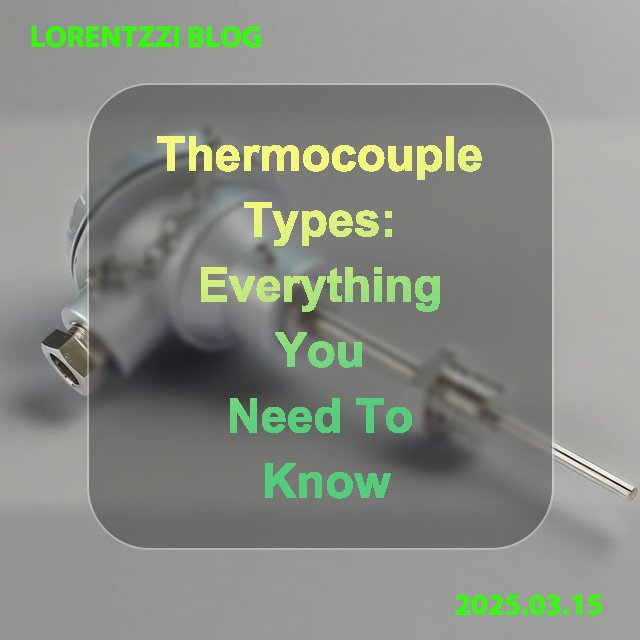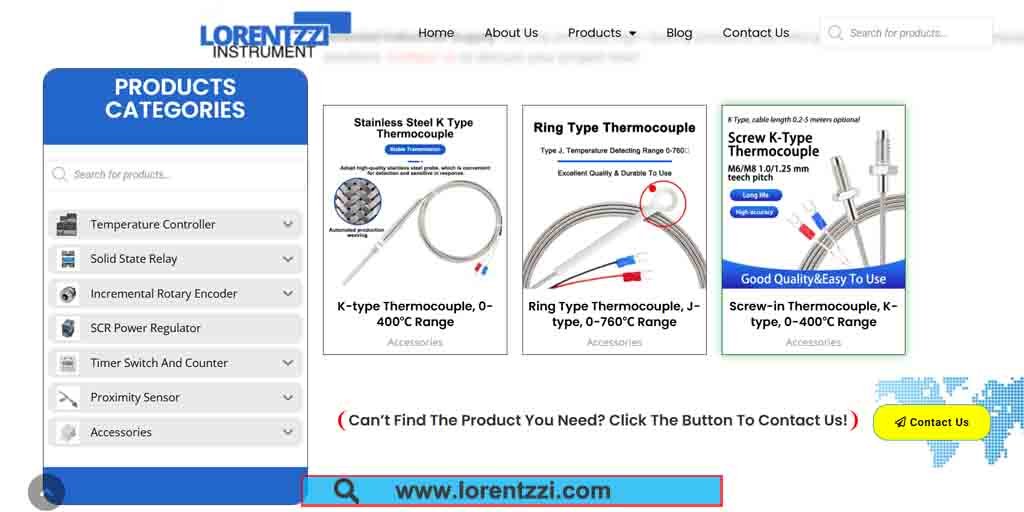Bir termokupl seçerken, piyasada çok fazla termokupl türü olduğunu görebilirsiniz. Uygulamanız için hangi tipin en iyisi olduğu konusunda hala tereddüt mü yaşıyorsunuz? Bu makale tüm termokuplları ve bunların avantaj ve dezavantajlarını listeleyecektir. Şimdi başlayalım!

Termokuplların çalışma prensibi aşağıdakilere dayanır termoelektrik etki (Seebeck etkisi). Bir termokuplun farklı malzemelerden iki iletkeni kapalı bir döngü oluşturduğunda ve sıcak uç ile soğuk uç farklı sıcaklıklarda olduğunda, döngüde küçük bir elektromotor kuvvet (basitçe Emf olarak adlandırılır) oluşacaktır.
Bu termoelektrik kuvvet ile sıcaklık farkı arasında belirli bir ilişki vardır. Termoelektrik kuvvet ölçülerek ve yukarıdaki sıcaklık-voltaj eğrileriyle birleştirilerek, ölçülen nesnenin sıcaklığı hesaplanabilir.
Genel olarak termokupllar K tipi, J tipi, E tipi, T tipi, N tipi, B tipi, S tipi, R tipi, C tipi ve M tipi olarak ayrılabilir. İlerleyen bölümlerde bunları tek tek açıklayacağız.
K tipi termokupl

K tipi termokupl, 10 tip termokupl arasında en yaygın kullanılanıdır.
Malzeme: nikel-krom alaşımı (pozitif elektrot) - nikel-silikon veya nikel-alüminyum alaşımı (negatif elektrot)
Sıcaklık ölçüm aralığı: -200 ℃ ila +1300 ℃
Özellikler: yüksek doğruluk, iyi stabilite, düşük fiyat ve en yaygın kullanılan.
Uygulama senaryoları: endüstriyel fırınlar, kurutma fırınları, gıda işleme, kimyasal reaktörler, vb.
J tipi termokupl
J tipi termokupl da yaygın olarak kullanılan bir sıcaklık sensörüdür, ancak sıcaklık ölçüm aralığı K tipi termokupldan daha dardır, bu nedenle sıcaklığın çok yüksek olmadığı ortamlar için daha uygundur.
Malzeme Demir (pozitif elektrot) - bakır nikel alaşımı (negatif elektrot)
Sıcaklık ölçüm aralığı: -40℃ ila +750℃
Özellikler: düşük maliyet, yüksek hassasiyet, ancak demir pozitif elektrot olduğu için antioksidan performansı zayıftır.
Uygulama senaryoları: düşük sıcaklık ölçümü, fırın sıcaklık kontrolü, kaynak sıcaklığı ölçümü vb.
E-tipi termokupl

Yukarıdaki şekilde gösterildiği gibi, E-tipi termokuplun voltaj/sıcaklık eğimi en büyüktür. Yani, aynı sıcaklıkta E-tipi termokupl, K-tipi ve J-tipi termokupllara kıyasla en yüksek voltajı verebilir ve sıcaklıkla değişimi de en büyüktür. Bu nedenle, E-tipi termokuplun sıcaklık ölçüm doğruluğu en yüksektir.
Malzeme: nikel-krom (pozitif elektrot) - bakır-nikel (negatif elektrot)
Sıcaklık aralığı: -200 ℃ ila +900 ℃
Özellikler: Yüksek hassasiyet, 5 yüksek hassasiyetli ölçüm için uygundur.
Uygulama senaryoları: Soğutma ekipmanı ve laboratuvar ekipmanı gibi düşük ila orta sıcaklık aralığındaki ölçümler.
T tipi termokupl

Yukarıdaki şekilde gösterildiği gibi, T tipi termokupllar düşük sıcaklık ortamlarında iyi doğrusallığa sahiptir, bu nedenle T tipi termokupllar çoğunlukla buzdolapları, soğuk hava depoları vb. gibi düşük sıcaklık algılama için kullanılır.
Malzeme Bakır (pozitif elektrot) - Bakır nikel (negatif elektrot)
Sıcaklık aralığı: -200 ℃ ila +400 ℃
Özellikler: Düşük sıcaklık ölçümü için uygundur, iyi anti-oksidasyon performansı.
Uygulama senaryosu: Soğutma ekipmanı, sıvılaştırılmış gaz depolama tankları gibi düşük sıcaklıklı ortam ölçümü.
Yukarıdaki bölüm ucuz metal termokuplları tanıtmaktadır. Bir sonraki bölümde, Tip B, Tip S ve Tip R gibi daha pahalı metal termokuplları tartışacağız. Neden pahalıdırlar, çünkü bu 3 termokuplun bileşimi şunlardan yapılmıştır plati̇n-rodyum alaşimi.

Tip B, Tip S ve Tip R termokuplların EMF'ye karşı sıcaklık eğrilerinden, her üç tipin de yaklaşık 1800°C'ye kadar ulaşan son derece yüksek bir maksimum sıcaklık ölçüm kapasitesine sahip olduğu açıktır. Şimdi bunların malzemeleri, avantajları, dezavantajları ve uygulamaları nelerdir? Şimdi öğrenmeye devam edelim.
N tipi termokupl
Malzeme: nikel-krom-silikon (pozitif elektrot) - nikel-silikon (negatif elektrot)
Sıcaklık aralığı: -200 ℃ ila +1300 ℃
Özellikler: K-tipinden daha iyi oksidasyon direnci, yüksek sıcaklık ölçümü için uygundur.
Tip B, tip R, tip S termokupl
B tipi bir termokupl pozitif elektrodu platin-rodyum alaşımıdır (oran 70:30) ve negatif elektrot platin-rodyum alaşımıdır (oran 94:6).
S-tipi ve R-tipi termokuplların pozitif elektrotları sırasıyla platin-rodyum alaşımı (oran 90:10) ve platin-rodyum alaşımıdır (oran 87:13) ve negatif elektrotların her ikisi de platindir.
B tipi termokuplun sıcaklık ölçüm aralığı 200℃-1800℃ olup düşük sıcaklık tespiti için kullanılamaz.
S ve R tiplerinin sıcaklık ölçüm aralığı -50 ℃-1700 ℃ olup, düşük sıcaklık tespiti için kullanılabilir, ancak yüksek sıcaklık fırınları, eritme fırınları vb. için daha uygundurlar.
Tip C ve tip M termokupllar

C-tipi ve M-tipi termokupllar nadiren kullanılır.
C tipi termokuplun pozitif elektrodu tungsten-renyum alaşımıdır (oran 74:26), negatif elektrot tungsten-renyum alaşımıdır (oran 95:5), sıcaklık aralığı 0°C ila +2320°C'dir, aşırı yüksek sıcaklık ölçümü için uygundur, ancak pahalıdır.
M tipi termokuplun pozitif elektrodu platin-kobalt alaşımıdır (oran 70:30), negatif elektrot platin-kobalt alaşımıdır (oran 94:6), sıcaklık aralığı -50°C ila +1800°C'dir.
Sonuç
Özetle, farklı termokupl türlerinin kendi avantajları ve dezavantajları vardır. J-tipi ve K-tipi termokupllar sıcaklık ölçümünde en yaygın kullanılanlardır.
At Lorentzzi®, sadece yüksek kalitede hizmet sunmakla kalmıyoruz sıcaklık kontrolörleri, ve aynı zamanda yüksek kaliteli termokupllar. Teknik sorularınız varsa veya fiyat teklifi almak istiyorsanız, lütfen Bize ulaşın Şimdi!










